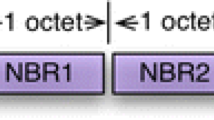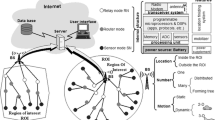Abstract
Sensor nodes have significant power constraints (battery life). Thus, power-aware approaches must be employed to prolong the network lifetime. However, most of the literature considers only routing-based approaches to prolong it. In this paper, we propose an index-based approach that provides a new way for reducing the energy consumption. The idea behind this new proposed approach is having an index for each possible value for a sensed reading. The index length will have much less length than the reading if the possible values for the sensed reading are limited. In this case, sending the corresponding index for a reading instead of the reading itself will result in decreasing the size of the submitted packet and therefore reducing the consumed energy. The experimental results show that our approach reduces both the total energy consumption and total elapsed time in the case the number of the possible different values for each sensed reading is up to 32,768 \((2^{15})\) and the size of each reading is 16 bits (MICA Motes).



Similar content being viewed by others
References
Liang, W., & Liu, Y. (2007). Online data gathering for maximizing network lifetime in sensor networks. IEEE Transactions on Mobile Computing, 6(1), 2–11.
Chakraborty, A., Mitra, S., & Naskar, M. (2010). An efficient hybrid data gathering scheme in wireless sensor networks. In The sixth international conference on distributed computing and internet technology, Bhubaneswar, India (pp. 98–103).
Chakraborty, A., Chakraborty, K., Mitra, S., & Naskar, M. (2009). An energy efficient scheme for data gathering in wireless sensor networks using particle swarm optimization. Journal of Applied Computer Science, 3(6), 9–13.
Lin, C., Huang, C., & Fang, R. (2008). A power-efficient data gathering scheme on grid sensor networks. In Proceedings of the 8th WSEAS international conference on multimedia systems and signal processing, Hangzhou, China (pp. 142–147).
Dabirmoghaddam, A., Ghaderi, M., & Williamson, C. (2010). Cluster-based correlated data gathering in wireless sensor networks. In Modeling, analysisand simulation on computer and telecommunication systems (pp. 163–171). Washington DC: IEEE Computer Society.
Zhu, Y., Wu, W., Pan, J., & Tang, Y. (2010). An energy-efficient data gathering algorithm to prolong lifetime of wireless sensor networks. Computer Communications, 33(5), 639–647.
Guidoni, D.L., Boukerche, A., Villas, L.A., Mini, R.A.F., Loureiro, A.A.F. (2011). A tree-based approach to design heterogeneous sensor networks based on small world concepts. In Proceedings of the 2011 IEEE 36th conference on local computer networks, Bonn, Germany (pp. 666–672).
Incel, O., Ghosh, A., Krishnamachari, B., & Chintalapudi, K. (2012). Fast data collection in tree-based wireless sensor networks. IEEE Transactions on Mobile Computing, 11(1), 86–99.
Delobel, F., Guitton, A., Misson, M., & Dargie, W. (2011). Minimization of the diffusion delay of a tree-based wireless sensor network. In Proceedings of the global communications conference, Houston, USA (pp. 1–6).
Kim, K., Lyu, C., Moon, S., & Youn, H. (2010). Tree-based clustering (TBC) for energy efficient wireless sensor networks. In Proceedings of the 2010 IEEE 24th international conference on advanced information networking and applications workshops, Perth, Australia (pp. 680–685).
Chan, E., & Han, S. (2009). Energy efficient residual energy monitoring in wireless sensor networks. International Journal of Distributed Sensor Networks, 5(6), 748–770.
Gong, H., Liu, M., Mao, Y., Chen, L., & Xie, L. (2006). Distributed energy efficient data gathering with intra-cluster coverage in wireless sensor networks. In Asia-pacific web conference (pp. 109–120).
Tam, T., Ngo, H., Truc, P., & Lee, S. (2008). Lifetime optimized hierarchical architecture for correlated data gathering in wireless sensor networks. In IEEE international conference on communication systems, Guangzhou, China (pp. 953–958).
Fan, Z., & Chen, Y. (2010). Mobility-assisted hierarchy for efficient data collection in wireless sensor networks. Journal of Communications, 5(9), 665–673.
Pham, M., Kim, D., & Yoo, S. (2005). Power aware chain routing protocol for data gathering in sensor networks. International Journal of Distributed Sensor Networks, 1(2), 253–267.
Gao, C., Zhao, G., Pan, S., & Zhou, J. (2009). Distributed multi-weight data-gathering and aggregation protocol in fleet wireless sensor networks: Optimal and heuristic algorithms. International Journal of Distributed Sensor Networks, 2(4), 1–8.
Abusaimeh, H., & Yang, S. (2009). Dynamic cluster head for lifetime efficiency in WSN. International Journal of Automation and Computing, 6(1), 48–54.
Duarte-Melo, E., & Liu, M. (2002). Analysis of energy consumption and lifetime of heterogeneous wireless sensor networks. In IEEE global telecommunications conference, Taipei, Taiwan (pp. 21–25).
Younis, O., & Fahmy, S. (2004). HEED: A hybrid, energy-efficient, distributed clustering approach for ad hoc sensor networks. IEEE Transactions on Mobile Computing, 3(4), 366–379.
Liu, C., Lee, C., & Wang, L. (2007). Distributed clustering algorithms for data-gathering in wireless mobile sensor networks. Journal of Parallel and Distributed Computing, 67(11), 1187–1200.
Xiang, M., Luo, Z., & Wang, P. (2010). Energy-efficient intra-cluster data gathering of wireless sensor networks. Journal of Networks, 5(3), 383–390.
Li, Q., Gong, H., Liu, M., Yang, M., & Zheng, J. (2011). On prolonging network lifetime through load-similar node deployment in wireless sensor networks. Sensors, 11(4), 3527–3544.
Haque, M., Matsumoto, N., & Yoshida, N. (2009). Context-aware cluster-based hierarchical protocol for wireless sensor networks. International Journal of Ad Hoc and Ubiquitous Computing, 4(6), 379–386.
Lee, S., Choe, H., Song, Y., & Kim, C. (2011). LUCA: An energy-efficient unequal clustering algorithm using location information for wireless sensor networks. Wireless Personal Communications, 56(4), 715–731.
Bsoul, M., Al-Khasawneh, A., Abdallah, A. E., Abdallah, E. E., & Obeidat, I. (2013). An energy-efficient threshold-based clustering protocol for wireless sensor networks. Wireless Personal Communications, 70(1), 99–112.
Peng, Y., Li, Y., Shu, L., & Wang, W. (2013). An energy-efficient clustered distributed coding for large-scale wireless sensor networks. The Journal of Supercomputing, 66(2), 649–669.
Cherian, M., & Nair, T. R. G. (2011). Multipath routing with novel packet scheduling approach in wireless sensor networks. International Journal of Computer Theory and Engineering, 3(5), 666–670.
Radi, M., Dezfouli, B., Bakar, K. A., & Lee, M. (2012). Multipath routing in wireless sensor networks: Survey and research challenges. Sensors, 12(1), 650–685.
Ganesan, D., Govindan, R., Shenker, S., & Estrin, D. (2001). Highly-resilient, energy-efficient multipath routing in wireless sensor networks. Mobile Computing and Communications Review, 5(4), 11–25.
Seah, W., & Tan, H. (2006). Multipath virtual sink architecture for wireless sensor networks in harsh environments. In Proceedings of the first international conference on integrated internet ad hoc and sensor networks, Nice, France.
Qaisar, S., & Radha, H. (2009). Multipath distributed data reliability for wireless sensor networks. In Proceedings of the 2009 IEEE international conference on communications, Dresden, Germany (pp. 330–334).
Chuang, P., Li, B., & Chao, T. (2007). Hypercube-based data gathering in wireless sensor networks. Journal of Information Science and Engineering, 23(4), 1155–1170.
Seetharam, A., Acharya, A., Bhattacharyya, A., & Naskar, M. (2009). Energy efficient data gathering schemes in wireless sensor networks using ant colony optimization. Journal of Applied Computer Science and Mathematics, 3(5), 19–28.
Fasolo, E., Rossi, M., Widmer, J., & Zorzi, M. (2007). In-network aggregation techniques for wireless sensor networks: a survey. IEEE Wireless Communications, 14(2), 70–87.
Lee, N., Levis, P., & Hill, J. (2002). Mica high speed radio stack. http://www.tinyos.net/tinyos-1.x/doc/stack.pdf
Wen, Y. (2004). Smart dust sensor mote characterization, validation, fusion and actuation: Research report. http://books.google.jo/books?id=6oJlHwAACAAJ
Shi, L., Han, J., Shi, Y., & Wei, Z. (2010). Cross-layer optimization for wireless sensor network with multi-packet reception. In ICST conference on communications and networking, Beijing, China.
Author information
Authors and Affiliations
Corresponding author
Rights and permissions
About this article
Cite this article
Bsoul, M., Kilani, Y., Hammad, M. et al. An Index-Based Approach for Wireless Sensor Networks. Wireless Pers Commun 82, 2185–2197 (2015). https://doi.org/10.1007/s11277-015-2341-2
Published:
Issue Date:
DOI: https://doi.org/10.1007/s11277-015-2341-2




